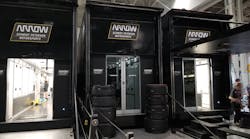IndyCar racing team Arrow Schmidt Peterson Motorsports travels across the U.S. and Canada to compete in races nearly every week during IndyCar season. The team has two drivers, meaning they have to haul two cars everywhere they go. Additionally, they carry replacement parts, and enough parts and components to build an entire backup car (minus the engine) in case anything should go wrong.
This adds up to three trailers hauling the cars, parts, and equipment, each weighing close to 80,000 lbs. The team depends on three Kenworth trucks, provided by Truck Service Inc. of Indianapolis, to get the cars and gear where they need to be for each race.
According to Jeff Darks, vice president of marketing for Arrow Schmidt Peterson Motorsports, the trucks travel from the team’s home base in Indianapolis to each race site. As quickly as two hours after a race ends, the trucks are back on the road headed home so the cars can be prepped for the next race. Then, it’s off again to a different location.
“These are our three tractors, and if one of them goes down, all of a sudden you’ve thrown a huge wrench into our transportation,” Darks says. “If these trucks don’t show up, you’ve got 45 guys standing here with no equipment to work on and we can’t race, so [uptime is] vital.”
Truck Service Inc. uses Petro-Canada Lubricants Duron heavy duty engine oil to maintain the trucks’ uptime and keep them on the road. Finding time to perform preventive maintenance (PM) on the trucks isn’t always easy, though, Darks explains.
“When they do have time - [for example] we just came off of a two-week break - they’ll be working on the generators, maintaining everything they can when they finally have a window to do that,” he says, adding why PMs are so important: “You get one maintenance issue, you lose a tractor.”
The team continues to rely on the Petro-Canada Lubricants product to get their cars and equipment where they need to be, when they need to be there.
Truck racing
Petro-Canada Lubricants gets even more directly involved in the racing scene, producing racing oil for the FIA European truck racing sport. According to John Pettingill, product specialist for Petro-Canada Lubricants, these 1,000-horsepower trucks run flat-out during races.
Over the course of six such competitions using the same oil, minimal viscosity loss due to shear was noted during used oil analysis. Iron wear metals in the oil also remained low, at around 20 parts per million (ppm). For reference, the industry standard threshold limit is 100 ppm.
CNG/LNG options
With today’s focus on reducing greenhouse gas emissions, more fleets are turning to alternative fuels such as compressed natural gas (CNG) and liquefied natural gas (LNG) to power their vehicles. However, CNG and LNG may not be a fit for all of a fleet’s vehicles, in which case gasoline and/or diesel will still be necessary.
Petro-Canada Lubricants Duron GEO LD engine oil line offers a solution for fleets with mixed engine types. It is approved for use with CNG, LNG, gasoline, and diesel engines, giving fleets an option to simplify their maintenance to one type of engine oil.
Related services
In addition to producing engine oils, Petro-Canada Lubricants also offers support and services. Their technical services team offers customers lubricant surveys, a technical helpline, onsite support and troubleshooting, and used oil analysis to determine the health of a fleet’s engines and appropriate oil drain intervals.
“We will go into a fleet, we will do a lube survey, we will look at all of the pieces of equipment that they have, and if there is an opportunity to consolidate or offer a better option for that customer - whether that be a synthetic or synthetic blend lubricant - we will do that,” says Ron LeBlanc Sr., senior technical services advisor for Petro-Canada Lubricants.
LeBlanc notes that Petro-Canada Lubricants also offers used oil analysis review to customers. Used oil analysis can be used to ensure optimal engine oil performance at current drain intervals, or to explore safely extending drain intervals.
“I do about 1,000 [used oil analysis] reviews a month,” he says. “I have everything from small engines to 1,200-horsepower engines in marine applications. It’s vitally important that our customers know we can review their oil samples and help guide them in whatever is happening during a normal drain interval, or the ability to extend.”
The company has also introduced an all-in-one online tool called Lube 360 Oil Diagnostics. It is designed to show customers in-depth oil performance information, forecasting trends to make decisions that will improve reliability and life of equipment, and more, according to LeBlanc.
Looking forward
With the rollout of new industry standards in December of 2016, Petro-Canada Lubricants offers certified API CK-4 and FA-4 engine oils. These oils are designed to provide better protection against oxidation, shear, and oil aeration, as well as lower viscosities to improve fuel efficiency.
Barnaby Ngai, category manager, heavy duty engine and driveline oils for Petro-Canada Lubricants, says the company has transitioned all of its customers to the new standards. Since CK-4 engine oils are backward compatible and FA-4 engine oils are designed for newer engines only, the former has a higher adoption rate.
Even though the new oil standards were implemented relatively recently, Petro-Canada Lubricants is already looking toward the future. John Pettingill, product specialist for Petro-Canada Lubricants, says the company is testing a 0W-20 prototype heavy duty diesel engine oil.
“We’re asking, ‘how low can we go with viscosity?’” he says. “Thinner is better. It’s less flow resistance due to the engine, it’s less parasitic losses, and you can expect to see some fuel economy improvements because of that.”
Pettingill notes that the oil is still in the testing stages now, but the potential benefits of a lower-viscosity oil are real.
“If we can demonstrate that we can make a 0W-20 oil that can protect as well as a 10W-30, 40, and 50, and still provide some fuel economy benefits because it is thinner, then that’s a real step toward what the future of engine oils will look like.”




